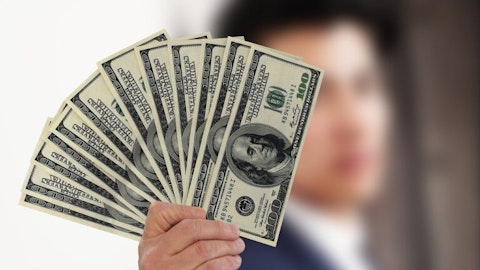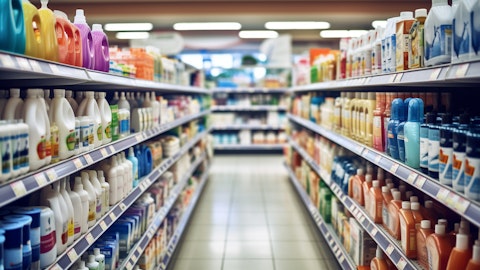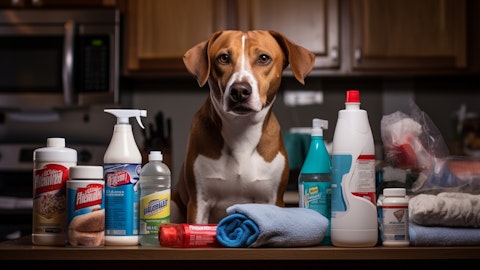David Maura: Yes. I think the first thing would be – just because we have certain competitors that are publicly traded, it doesn’t mean that our mix of sales is the same. And so I think you need to look at the mix of sales of our competitors, a lot of them sell seed and growing media stuff, and we don’t. And before you have weeds, you need to grow something, and we come in and kill the weeds after you grow stuff. So there might be a timing difference there. Jeremy, anything you want to add to the question other than…
Jeremy Smeltser: I think that’s exactly right. I think the earlier load-in for home centers happens for a lot of those things that we don’t do that David just mentioned. So I think that’s why you hear what we are – that’s why you hear what you hear from competitors.
Brian McNamara: Okay. And then secondly, on HPC, I mean, I think we’re six quarters in on some pretty significant declines on the topline. I guess, what gives you guys confidence that we should see a return to growth in H2? And any color on the phasing as it relates to Q3 and Q4 would be helpful? Thanks.
David Maura: Yes. Look, I think the last 12 months – again, sing Tim Wright’s praises, he and I have been on a lot of airplanes. We’ve been meeting with a lot of customers. We’ve been making up for past sins, and we’ve been trying to fix relationships, mend fences and bring them better product offerings. And so I think a couple of years ago, we were telling retailers we were exiting certain brands. And I think we had some missteps with an acquired business. And we’ve spent a very good amount of time in the last 12, 18 months really fixing relationships, cleaning up the marketplace, owning our sins and then bringing forth new product and new innovation. And so actually, I’m pretty bullish on regaining listings as we go forward.
Even some of them hitting as early as the fourth quarter of this fiscal year. So much more solid footing. And again, all credit to the team. A lot of new talent particularly being hired in the North America market as we fix that and make that more profitable and restore it to growth like our European markets.
Brian McNamara: Maybe if I could just squeeze one last one in for Jeremy on the housekeeping front. On gross margin, obviously, a big expansion year-over-year in Q1. Is this kind of mid-30s range a reasonable run rate to expect for the full-year?
Jeremy Smeltser: I think it is, yes. I think not a lot of variables that we’re seeing on inflation. The only real caution that we see on the radar right now is the Red Sea surcharges that I mentioned. So we’re watching that closely, obviously, but I would expect that we can continue at this pace as the year progresses on gross margins.
Brian McNamara: Thanks a lot. Best of luck guys.
Operator: Thank you. Our next question comes from the line of Ian Zaffino with Oppenheimer.
Ian Zaffino: Great. Thank you very much. I just wanted to ask one more question on HPC. As far as divesting or any corporate action there, why now? What’s giving you the confidence to maybe move forward on that? I think when you did Tristar, I think you guys threw out like an over $100 million EBITDA number. We’re not quite there yet. So what are you sort of planning for as far as EBITDA in that business? What do you think maybe the underlying profitability of it is? And do you still think it’s at that level you previously said? And again, why now versus waiting to bring it back maybe to that level? Thanks.
David Maura: I mean actually, I think our investor base believes, as I do, that we have higher multiple trading businesses in Pet and Home & Garden. And I think our investor base believes that separating appliances out will allow our main co to trade at a higher valuation. That’s the premise of doing it in the first place. I think that we clearly anticipated trying to get it out sooner rather than later, and we entered the pandemic and supply chain and all the wonderful things that we talked about earlier in the call. And I just – I think as we get it back to health, it belongs – to stand up on its own. We’d like to continue to have some management and some ownership in it, but the only thing we can control within our – without a counterparty is a spin.
And so that’s our fiduciary obligation. And – but we’re putting a lot of money behind it. We’re hiring a lot of new talent, and we believe that we can build a global champion with that appliance business and stand it up. But I think – talking to shareholders, shareholders would like me to get it independent of Pet and Home & Garden. And so we’re just letting you know as we did all of last year, we need to get this thing healthy profitably. We don’t want to spend something out that isn’t healthy, and so we want to get the company healthy. But as we restore health and profitability, we’re going to ramp up efforts to separate it.
Jeremy Smeltser: Yes. And I’d just add, Ian, from the color, from a timing perspective, right? I mean, look, we just reported a quarter where we doubled EBITDA year-over-year, $26 million and change. And as I mentioned in my prepared remarks, we’re expecting really each quarter the next couple of quarters sequentially for the topline to improve. We mentioned that every region, with the exception of North America, is now growing organically. And so we’re implying that North America is going to get better. It got better in Q1. We think more of that’s coming. We’re winning more in e-com. We’re starting to get more shelf placements with some of the legacy brands that we had lost some in the past couple of years. And so I think all those things just lend themselves to a better marketing story for the business in any event, whether it’s a spin or a private transaction. So that’s the point of us saying we’re going to accelerate that now as we see the forecast improving.
Ian Zaffino: Okay. Thank you very much.
Jeremy Smeltser: Thank you.
Operator: Thank you. Our next question will come from the line of Olivia Tong with Raymond James.
Olivia Tong: Great, thanks. Good morning. I wonder if you could talk a little bit more about what you’re changing to position yourself to drive the innovations and eventually topline growth that you’re talking about, whether it’s additional personnel? You mentioned some managerial changes, investments that you have made or planning to make. And when you – when do you think you actually start to see that year-over-year improvement in aggregate? And then just sort of where that growth is necessarily coming from? And then you talked about profitable growth, but can you talk about also magnitude of brand spend, especially as you pivot to more of a focus on revenue growth? It’s obviously been a tough – tough go over the last couple of years. So as you consider new products, innovation, et cetera, what you’re doing in order to support healthy launches when the time comes and what’s embedded into the outlook? Thank you.
David Maura: I think the main thing is the mindset shift. I think years ago, we had an approach where each R&D department or NPD Group would look at 50 or 100 projects. And I don’t think any one of these particular projects in the past were big bets. I think people looked at, okay, let’s tweak this packaging, let’s tweak the color, let’s tweak a feature. Maybe if we get a listing here, it’s another $1 million, if it fails, it’s not that big a failure. And you just can’t move a needle if you’re constantly trying to launch 100 products a year in Home & Garden or a 100 new products a year [indiscernible]. We put it in the press and in the script, we’ve hired a lot of new talent, and we’ve changed the mindset to be – we want to take more risk.
We want to launch fewer, bigger, better innovations. And it brings a lot of focus and clarity, quite frankly, to your organization. If instead of focusing people on 100 new SKUs, you say, look, we want 10 new products and we wanted to really move the needle where can you move the needle. And so you’ve already seen it. You see little green shoots of it, right? We’re very, very good in dog chews and treats, but we’ve never been in cat. We did an amazing acquisition in the U.K. called Armitage. It brought us a brand called Good Boy, and it brought us Meowee. And we’re taking those businesses and we’re launching complementary products into the pets space in the U.S., particularly cat treats. The other thing that is very different that we never did in the past – and a lot of credit to [Mir] and our Comm Ops team – we do stuff now called test and learn.
And so we don’t work on a product and then take it to every brick-and-mortar and say, here it is, we want to test and learn that product with the customer in real time so that we get feedback on that product. We refine that product with – not some survey, not some theory, but thousands of customers telling us what’s good with it, what’s wrong with it, and then we refine that product offering to create a fat pitch. And that is a very different approach, but we believe it has potential to yield big results. And so that’s – I think that’s a little bit of the answer to your question. Hopefully, it helps a little bit. Jeremy, is there another part of that question?
Jeremy Smeltser: Yes. I think the last part of the question was on timing. We’re seeing some wins. I think they start to impact our financial results in the second half of the year from a topline perspective, which is why we talk about our confidence in growth in the second half. So it’s – I think it’s coming very shortly.
Olivia Tong: Thank you.
Jeremy Smeltser: Thanks, Olivia.
Operator: Thank you. Our next question will come from the line of Michael O’Brien with Wolfe Research.
Michael O’Brien: Hi. Good morning guys. Just a quick one here. So regarding the margin structure. So obviously, you have this high-cost inventory rolling off, which is going to be a tailwind to the business. Could you provide a little bit more color though on any other margin improvement initiatives that you’re currently undergoing? And then my second question is to offset some of the volume decreases, are you planning to increase price in the back half of this year as well? Thank you.




